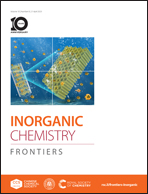Cationic defect-enriched hydroxides as anodic catalysts for efficient seawater electrolysis†
Abstract
Seawater electrocatalysis driven by renewable energy resources has long been considered as a promising approach for producing clean hydrogen. However, anodic electrode materials suffer from severe issues such as large overpotential and electrochemical corrosion during seawater electrolysis due to the existence of abundant chloride ions. Herein, we report a cationic defect engineering approach to tailoring the structure of NiFe layered double hydroxide (NiFe LDH) for the oxygen evolution reaction (OER) in an alkaline seawater-like solution. Impressively, the obtained cation defect-enriched NiFe LDH array exhibits an extremely low overpotential of 232 mV at 100 mA cm−2 and excellent durability after 40 h electrolysis. The density functional theory (DFT) calculations show that CD-NiFe LDH-E facilitates charge transfer between metals (Ni/Fe) and oxygen (O), leading to inhibition of the competitive chlorine evolution reaction (CER). Moreover, homemade rechargeable Zn–air batteries with CD-NiFe LDH-E as the cathode are assembled, exhibiting high open circuit voltage (1.4 V) and excellent stability after 250 hours at a charging–discharging rate of 10 mA cm−2. The strategy is expected to pave the way for the future development of high-performance electrocatalysts toward seawater splitting.



 Please wait while we load your content...
Please wait while we load your content...